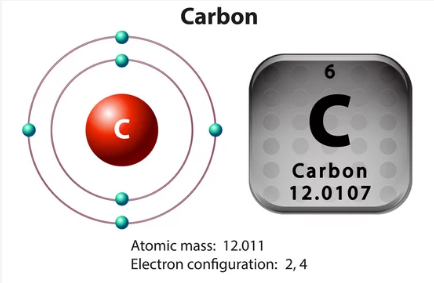- Written By
Sahana Soma Kodarkar
- Last Modified 03-04-2025
Important Trends and Anomalous Behaviour of Carbon: Factors Attributed Anomalous Behaviour of Carbon
Important Trends and Anomalous Behaviour of Carbon: You know how important carbon is for our existence. Even our bodies are largely composed of carbon compounds. It has many harmful effects on our environment but does not deny that carbon is essential for life on earth. However, the carbon properties are very interesting to notice. Carbon shows a lot of anomalous behaviour. Why is this happening? To learn more about the important trends and anomalous behaviour of carbon, read the below article.
Carbon
Carbon belongs to group \(14\) of the periodic table. In the form of graphite, diamond, coal, charcoal, etc. It has been known since very early times. Carbon is a very widely distributed element and ranks seventeenth in the order of abundance in the earth’s crust. It is an essential component of all living systems and is present in all plants and animals in the form of proteins, carbohydrates, fats, and other complex compounds.
Know About Uses Of Carbon Here
As hydrocarbons, it occurs in oil and gas from swamps. In the atmosphere, it is in the form of carbon dioxide, while in the mineral world it occurs as carbonates. Diamond, graphite, coal, coke, charcoal, etc., are some of its various allotropic forms and have been known to humans since time immemorial. Carbon forms a variety of compounds. Compounds of carbon can be divided into two categories, inorganic and organic compounds. Organic compounds are so numerous.
Anomalous Behaviour of Carbon
Carbon, the first element of group \(14\), differs from the other elements of its own group in several properties and therefore shows an anomalous behaviour.
The anomalous behaviour of carbon can be attributed to the following factors:
- Its Small Atomic Size and its Higher Electronegativity:
Due to its small size and high electronegativity, carbon has a strong tendency to form \({\rm{p}}_\pi – {\rm{p}}_\pi\) multiple bonds either with itself \([{\rm{C = C}},\, – {\rm{C}} \equiv {\rm{C}} – ,]\) or with other atoms such as oxygen \((\rm{C = O})\), nitrogen \(({\rm{C = N}},\,{\rm{C}} \equiv {\rm{N}})\) and sulphur \((\rm{C = S})\). The remaining elements, on the other hand, do not form \({\rm{p}}_\pi – {\rm{p}}_\pi\) bonds because their atomic orbitals are too vast and dispersed to overlap effectively. Instead, they tend to form \({\rm{d}}_\pi – {\rm{p}}_\pi\) bonds because of the presence of \({\rm{d}}-\)orbitals. Even when the size of the \({\rm{d}}-\)orbitals grows, the tendency to form \({\rm{d}}_\pi – {\rm{p}}_\pi\) bonds diminishes down the group from \(\rm{Si}\) to \(\rm{Pb}\).
- Its Strong Catenation Tendency
Catenation: Catenation is a unique characteristic of carbon, which is described as the capacity of similar atoms to form covalent connections with one another. The smaller size and stronger electronegativity of carbon atoms, as well as the unusual strength of carbon-carbon bonds, account for this. The strength of the element-element link determines the catenation property.Since the bond energy of the \({\rm{C – C}}\) bond is very large \((348\,{\rm{kJ}}\,{\rm{mol}}^{-1})\) carbon forms long straight or branched \({\rm{C – C}}\) chains or rings of different sizes and shapes. However, as we move down the group, the element-element bond energies decrease rapidly, \({\rm{C – C}}\) \((348\,{\rm{kJ}}\,{\rm{mol}}^{-1})\), \({\rm{Si – Si}}\) \((297\,{\rm{kJ}}\,{\rm{mol}}^{-1})\), \({\rm{Ge – Ge}}\) \((260\,{\rm{kJ}}\,{\rm{mol}}^{-1})\), \({\rm{Sn – Sn}}\) \((240\,{\rm{kJ}}\,{\rm{mol}}^{-1})\), \({\rm{Pb – Pb}}\) \((81\,{\rm{kJ}}\,{\rm{mol}}^{-1})\), and therefore, the tendency for catenation decreases in the order.
\({\text{C}} \gg {\text{Si > Ge}} \approx {\text{Sn}} \gg {\text{Pb}}\)
Due to the property of catenation and \({\rm{p}}_\pi – {\rm{p}}_\pi\) bond formation, carbon shows allotropic forms.
- Tetravalency
Carbon has only four valence orbitals (one \(2\rm{s}\) and three \(2\rm{p})\), therefore, at the maximum, it can accommodate four pairs of electrons around it. As a result, carbon’s maximum covalency is \(4\). Due to the presence of \(\rm{d}-\)orbitals, the other members of this group can increase their covalency to \(6\). Thus, carbon does not form \({\left[ {{\text{C}}{{\text{F}}_{\text{6}}}} \right]^{{\text{2 – }}}}\) whereas silicon forms \({\left[ {{\text{Si}}{{\text{F}}_{\text{6}}}} \right]^{{\text{2 – }}}}\).
The important properties in which carbon differs from the other elements of the group are as follows:
- Carbon is much harder than the other elements of the group. Diamond is an allotrope of carbon, is the hardest substance known.
- The tendency of catenation is maximum for carbon. The other elements of the group have a lesser tendency towards catenation.
- The melting and boiling point of carbon is much higher as compared to other elements of the group.
- Carbon possesses a remarkable ability to form \({\rm{p}}_\pi – {\rm{p}}_\pi\) multiple bonds with itself and with other non-metals such as nitrogen, oxygen, sulphur, etc. As a result, it forms a large number of compounds containing \({\rm{C}} = {\rm{C}}, – {\rm{C}} \equiv {\rm{C}} – , – {\rm{C}} = {\rm{O}}, – {\rm{C}} \equiv {\rm{N,C = S}}\), etc., functional groups. The other members of the group do not form \({\rm{p}}_\pi – {\rm{p}}_\pi\) multiple bonds. However, they form a few multiple bonds through \({\rm{d}}_\pi – {\rm{p}}_\pi\) overlapping.
- \(\rm{CO}_2\) is a gas at room temperature, while the dioxides of the other elements are networks solids.
- \(\rm{CCl}_4\) does not undergo hydrolysis, whereas tetrachlorides of other elements do.
- Carbon does not take part in complex formation due to the absence of vacant \(\rm{d-}\)orbitals in its valence shell. On the other hand the other elements of the group form complexes.
Summary
Carbon belongs to group \(14\) of the periodic table. In the form of graphite, diamond, coal, charcoal, etc., It has been known since very early times. It is an essential component of all living systems. Carbon forms a variety of compounds. Compounds of carbon can be divided into two categories, inorganic and organic compounds. The factors that attribute carbon’s anomalous behaviour are small atomic size, higher electronegativity, and the absence of vacant \(\rm{d-}\)orbitals in its valence shell.
Multiple Choice Questions on Important Trends and Anomalous Behaviour of Carbon
- The tendency to form pπ –pπ multiple bonds in group 14 is most prominent for
- C
- Si
- Sn
- Pb
Ans: A
Hint: This element is the backbone of organic compounds.
- The tendency of catenation is maximum for _____.
- Carbon
- Silicon
- Tin
- none of the above
Ans: A
Hint: It is a chemical element that does not have d orbitals.
- Which does not exist?
- [CCl6]2-
- [SiCl6]2-
- [GeF6]2-
- [SnCl6]2-
Ans: A
Hint: Recall the valency of the central element.
- Graphite is a good conductor of electricity because it contains
- bonded electrons
- mobile electrons
- strong C-C bonds
- strong C=C bonds
Ans: B
Hint: The negatively subatomic particle in graphite is free.
- Catenation depends on the size and electronic configuration of atoms. The tendency of catenation in group 14 elements follows the order:
- C > Si > Ge > Sn
- C>> Si > Ge ≈ Sn
- Si > C > Sn > Ge
- Ge >Sn > Si > C
Ans: B
Hint: Tendency of catenation decreases down the group.
- Carbon shows allotropic forms due to the property of
- Catenation
- hybridization
- Both A and B
- None of the above
Ans: A
Hint: It is defined as the ability of like atoms to link with one another through covalent bonds.
- Which of the following is the hardest substance known?
- Graphite
- Diamond
- Fullerenes
- All the above
Ans: B
Hint: It is used in making jewellery.
- Which of the following is gas at room temperature?
- Carbon dioxide
- Silicon dioxide
- Lead oxide
- Tin oxide
Ans: A
Hint: The plant utilizes this gas during photosynthesis.
- Carbon and Silicon belong to group 14. The maximum coordination number of carbon in commonly occurring compounds is 4, whereas that of silicon is 6. This is due to
- The large size of silicon
- More electropositive nature of silicon
- Availability of d-orbitals in silicon
- Both A and B
Ans: C
Hint: Recall the orbitals valence shell in the second member of the group 14 element.
- Which of the following statement is correct with respect to the property of elements
in the carbon family with an increase in atomic number, their
- atomic size decreases
- ionisation energy increases
- metallic character decreases
- stability of +2 oxidation state increases
Ans: D
Hint: Recall the screening effect.
FAQs on Important Trends and Anomalous Behavior of Carbon
Q.1. What are the important trends and the anomalous behaviour of carbon?
Ans: Carbon shows anomalous behaviour due to the following reasons;
1. Small atomic size
2. High ionization enthalpy and electronegativity
3. absence of vacant \(\rm{d}-\)orbitals in the valence shell
4. Its strong catenation tendency
Important trends and anomalous behaviour of carbon are as follows;
1. Carbon is much harder than the other elements of the group. Diamond is an allotrope of carbon, and is the hardest substance known.
2. The tendency of catenation is maximum for carbon. The other elements of the group have a lesser tendency towards catenation.
3. The melting and boiling point of carbon is much higher as compared to other elements of the group.
4. Carbon possesses a remarkable ability to form \({\rm{p}}_\pi – {\rm{p}}_\pi\) multiple bonds with itself and with other non-metals such as nitrogen, oxygen, sulphur, etc. As a result, it forms a large number of compounds containing \({\text{C = C}},\; – {\text{C}} \equiv {\text{C}} – ,\; – {\text{C = O}},\; – {\text{C}} \equiv {\text{N}},\;{\text{C = S,}}\), etc functional groups. The other members of the group do not form \({\rm{p}}_\pi – {\rm{p}}_\pi\) multiple bonds. However, they form a few multiple bonds through \({\rm{d}}_\pi – {\rm{p}}_\pi\) overlapping.
\(\rm{CO}_2\) is a gas at room temperature, while the dioxides of the other elements are network solids.
\(\rm{CCl}_4\) does not undergo hydrolysis, whereas tetrachlorides of other elements do.
Carbon does not take part in complex formation due to the absence of vacant \(\rm{d}-\)orbitals in its valence shell. On the other hand the other elements of the group form complexes.
Q.2. Why does the carbon element show anomalous behaviour?
Ans: Carbon shows anomalous behaviour due to the following reasons;
1. Small atomic size
2. High ionization enthalpy and electronegativity
3. Absence of vacant d-orbitals in the valence shell
4. Its strong catenation tendency
Q.3. What is the anomalous behaviour of carbon in Group \(14\)?
Ans: The anomalous behaviour of carbon is attributed to
1. Carbon dioxide is a gas at room temperature while silicon dioxide and similar oxides of other elements are solids at room temperature.
2. Carbon has a maximum tendency to catenation while this tendency is less in silicon and very small in other members.
3. Carbon tetrachloride cannot be hydrolysed by water. On the other hand, silicon tetrachloride and other similar chlorides can be readily hydrolysed.
4. Carbon participates in the multiple bonding with carbon, oxygen, and nitrogen while the tendency to form multiple bonds is less in other members.
5. Carbon can show a maximum covalency of four in its compounds and does not take part in complex formation.
6. Silicon and other elements can also exhibit higher covalency of six and participate in complex compound formation as well.
7. \(\rm{CO}_2\) readily dissolves in water to form \({\rm{H}}_2 {\rm{CO}}_3\) which is a weak acid. \({\rm{SiO}}_2\) and other similar oxides are insoluble in water.
Q.4. What is anomalous behaviour in chemistry?
Ans: Anomalous behaviour is defined as behaviour that deviates from its normal pattern.
Q.5. What are the factors for showing anomalous behaviour by an element?
Ans: The factors for showing anomalous behaviour by an element is due to:
1) Its small size
2) High charge to radius ratio
3) High ionization enthalpies
4) High electronegativity
5) The valence shell is devoid of \(\rm{d}-\)orbitals.
Learn Everything About Carbon And Its Compounds Here
We hope this article on Important Trends and Anomalous Behaviour of Carbon has helped you. If you have any queries, drop a comment below and we will get back to you.









































